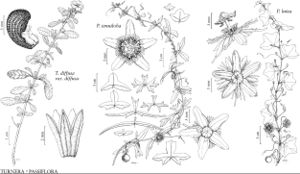Difference between revisions of "Turnera diffusa var. diffusa"
FNA>Volume Importer |
FNA>Volume Importer |
(No difference)
| |
Revision as of 22:43, 16 December 2019
Shrubs 0.3–1.2[–2] m, hairs simple and sessile-capitate glandular. Leaves aromatic; petiole absent or to 3.5(–7) mm, without nectaries; blade obovate or ovate, 5–30 × 2–13 mm, base cuneate or attenuate, margins revolute, crenate-serrate, apex obtuse, surfaces tomentose to pilose abaxially, often glabrate adaxially. Inflorescences not epiphyllous, 0.5–0.8 cm; peduncle inserted at foliar base, 0.3–1(–2) mm; prophylls inserted at peduncle apex, ovate-lanceolate, 2.5–7 × 0.4–2.5 mm, without nectaries. Flowers distylous; calyx 3–8 mm, tube 2–5 mm; petals usually yellow, rarely whitish, 4–7(–9) × 1.5–4(–7) mm; filaments adnate 0.2 mm to floral tube from base, 3–3.5 mm in long-styled flowers, (2–)4.5–7.5 mm in short-styled flowers, nectaries absent; anthers dorsifixed; styles 2–4.5 mm in long-styled flowers, 1–2 mm in short-styled flowers. Capsules ovoid, 2.5–4.5 × 2–3 mm, rugose or verrucose. Seeds blackish, 1.5–2.2 × 0.7–1.1 mm; epidermis smooth; aril 0.9–1.5 mm. 2n = 14.
Phenology: Flowering and fruiting Sep–Mar.
Habitat: Gravelly, brushy hills, sandy soil
Elevation: 50–100 m
Distribution

Tex., Mexico, West Indies, Central America, South America (ne Brazil).
Discussion
Selected References
None.
